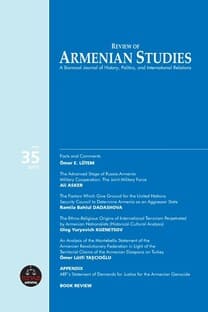Intra-or international violence? the origins of armenian terrorism
(Ulusal ya da uluslararası şiddet? ermeni terörizminin kökenleri)
___
Ankara University. Armenian Terrorism, Its Supporters, the Narcotic Connection, the Distortion of History. Ankara, Turkey: Ankara University, 1984.Armenian Atrocities and Terrorism: Testimonies of Witnesses. Washington, DC: Assembly of Turkish American Associations, 1997.
Birand, Mehmet Ali. "Thanks to Nuri Gündeş." Turkish Daily News, February 10, 2007. http://arama.hurrivet.com.tr/arsivnews.aspx?id=-599507
Bobelian, Michael. Children of Armenia: A Forgotten Genocide and the Century-Long Struggle for Justice. New York: Simon &Schuster, 2009.
Chaliand, Gerard and Arnaud Blin, eds. The History of Terrorism from Antiquity to Al Qaeda. Berkeley and Los Angeles, CA: University of California Press, 2007.
Corsun, Andrew. "Armenian Terrorism: A Profile." In Department of State Bulletin Vol. 82, No. 2065 (August 1982): 31-35.
Department of State. "Patterns of International Terrorism: 1981." In Department of State Bulletin Vol. 82, No. 2065 (August 1982): 9-21.
Dekmejian, R.H. "Soviet-Turkish Relations and Politics in the Armenian SSR." In Soviet Studies Vol. 19, No. 4 (April 1968): 510-525.
Elad, Shlomi and Ariel Merari. The Soviet Bloc and World Terrorism. Boulder, CO: Worldview Press, 1984.
Goren, Roberta. The Soviet Union and Terrorism. Winchester, MA: Allen & Unwin, 1984.
Gunter, Michael M. "Pursuing the Just Cause of their People ": A Study of Contemporary Armenian Terrorism. Westport, CT: Greenwood Press, 1986.
Henze, Paul. Goal: Destabilization. Soviet Agitational Propaganda, Instability and Terrorism in NATO South. Marina Del Ray, CA: European American Institute for Security Research, 1981.
Kurz, Anat and Ariel Merari. ASALA—Irrational Terror or Political Tool. Boulder, CO: Westview Press, 1985.
Mango, Andrew. Turkey and the War on Terror: For Forty Years We Fought Alone. New York: Routledge, 2005.
Mango, Andrew."Historiography by Political Committee and Committed Historians: Review Article." In Middle Eastern Studies Vol. 25, No. 4 (October 1989): 531-562.
Miller, Donald E. and Lorna Touryan Miller. "Memory and Identity Across the Generations: A Case Study of Armenian Survivors and their Progeny." In Qualitative Sociology Vol. 14, No. 1 (1991): 13-38.
Popular Movement for the ASALA. ASALA Interviews. Britain, April 1982. (UCLA Library).
Sezer, Duygu B. "Peaceful Coexistence: Turkey and the Near East in Soviet Foreign Policy." In Annals of the American Academy of Political and Social Science Vol. 481 (September 1985): 117-126.
Shughart, William F. "An Analytical History of Terrorism, 1945-2000." In Public Choice Vol. 128, No. 1-2 (2006): 7-39.
Şimşir, Bilal N. Şehit Diplomatlarımız (1973-1994). Vol. 2. Ankara, Turkey: Bilgi Yayınevi, 2000.
Snitch, Thomas H. "Terrorism and Political Assassinations: A Transnational Assessment, 1968-80." In Annals of the American Academy of Political and Social Science Vol. 463 (September 1982): 54-68.
- ISSN: 1303-5304
- Yayın Aralığı: 2
- Başlangıç: 2002
- Yayıncı: Terazi Yayıncılık Basım Dağıtım Danışmanlık Eğitim Organizasyon Matbaacılık Kırtasiye Tic. Ltd. Şti.
France's entanglement in the armenian genocide issue
SOSYAL DARVİNİZM VE DOĞU SORUNU
The first american academic book critical of the armenian genocide thesis
ERMENİ İDDİALARININ ULUSLARARASI CEZA HUKUKU AÇISINDAN BİR DEĞERLENDİRMESİ
TÜRKİYE VE ERMENİSTAN: MERHAMETLİ BİR ORTAK AKLA İHTİYAÇ
ULUSAL YA DA ULUSLARARASI ŞİDDET? ERMENİ TERÖRİZMİNİN KÖKENLERİ
ERMENİSTAN’IN DIŞ POLİTİKASI: KÜÇÜK DEVLET AYRILIKÇILIĞI
Turkey and armenia: the need for compassion with common sense
A different dimension of turcophobia: "Armenian genocide" memorials in the world
